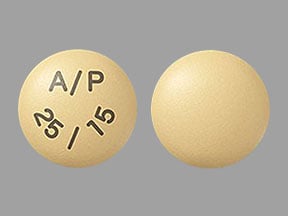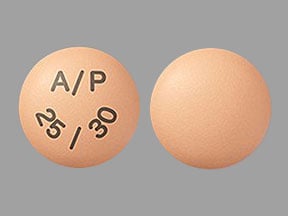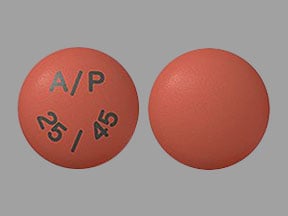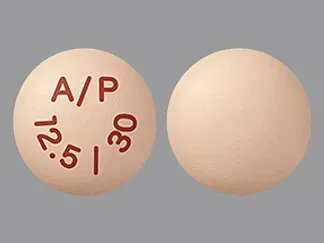Boxed Warning
Congestive heart failure:
Thiazolidinediones, including pioglitazone, cause or exacerbate congestive heart failure (CHF) in some patients. After initiation and after dose increases, monitor patients carefully for signs and symptoms of heart failure (eg, excessive, rapid weight gain; dyspnea, edema). If heart failure develops, it should be managed according to current standards of care, and discontinuation or dose reduction of alogliptin/pioglitazone must be considered.
Alogliptin/pioglitazone is not recommended in patients with symptomatic heart failure. Initiation in patients with established New York Heart Association (NYHA) class III or IV heart failure is contraindicated.
Dosage Forms
Excipient information presented when available (limited, particularly for generics); consult specific product labeling.
Tablet, Oral:
Oseni: Alogliptin 25 mg and pioglitazone 15 mg, Alogliptin 25 mg and pioglitazone 30 mg, Alogliptin 25 mg and pioglitazone 45 mg, Alogliptin 12.5 mg and pioglitazone 15 mg, Alogliptin 12.5 mg and pioglitazone 30 mg, Alogliptin 12.5 mg and pioglitazone 45 mg
Generic: Alogliptin 12.5 mg and pioglitazone 15 mg, Alogliptin 12.5 mg and pioglitazone 30 mg, Alogliptin 12.5 mg and pioglitazone 45 mg, Alogliptin 25 mg and pioglitazone 15 mg, Alogliptin 25 mg and pioglitazone 30 mg, Alogliptin 25 mg and pioglitazone 45 mg
Pharmacology
Mechanism of Action
Alogliptin inhibits dipeptidyl peptidase 4 (DPP-4) enzyme resulting in prolonged active incretin levels. Incretin hormones (eg, glucagon-like peptide-1 [GLP-1] and glucose-dependent insulinotropic polypeptide [GIP]) regulate glucose homeostasis by increasing insulin synthesis and release from pancreatic beta cells and decreasing glucagon secretion from pancreatic alpha cells. Decreased glucagon secretion results in decreased hepatic glucose production. Under normal physiologic circumstances, incretin hormones are released by the intestine throughout the day and levels are increased in response to a meal; incretin hormones are rapidly inactivated by the DPP-4 enzyme.
Pioglitazone is a thiazolidinedione antidiabetic agent that lowers blood glucose by improving target cell response to insulin, without increasing pancreatic insulin secretion. It has a mechanism of action that is dependent on the presence of insulin for activity. Pioglitazone is a potent and selective agonist for peroxisome proliferator-activated receptor-gamma (PPARgamma). Activation of nuclear PPARgamma receptors influences the production of a number of gene products involved in glucose and lipid metabolism. PPARgamma is abundant in the cells within the renal collecting tubules; fluid retention results from stimulation by thiazolidinediones which increases sodium reabsorption.
Use: Labeled Indications
Diabetes mellitus, type 2: As an adjunct to diet and exercise to improve glycemic control in adults with type 2 diabetes mellitus when treatment with both alogliptin and pioglitazone is appropriate as monotherapy or combination therapy.
Contraindications
Serious hypersensitivity (eg, anaphylaxis, angioedema, severe dermatologic reactions) to products that contain alogliptin, pioglitazone, or any component of the formulation; initiation in patients with NYHA Class III or IV heart failure
Dosage and Administration
Dosing: Adult
Diabetes mellitus, type 2: Oral:
Initial:
Patients inadequately controlled on diet and exercise, metformin alone, or alogliptin alone: Alogliptin 25 mg/pioglitazone 15 mg or alogliptin 25 mg/pioglitazone 30 mg once daily
Patients inadequately controlled on pioglitazone alone: Alogliptin 25 mg per day plus current daily dose of pioglitazone given once daily
Patients with asymptomatic NYHA Class I or II heart failure: Initiate cautiously with alogliptin 25 mg/pioglitazone 15 mg once daily. Note: Not recommended in patients with symptomatic heart failure and contraindicated with stage III or IV heart failure; the American Diabetes Association generally recommends avoiding thiazolidinediones in the setting of heart failure (ADA 2019).
Patients switching from individual alogliptin and pioglitazone administration: Initial doses should be based on current dose of alogliptin and pioglitazone given once daily
Dosage titration: May titrate gradually with careful monitoring of adverse effects (eg, weight gain, edema, signs/symptoms of heart failure). Maximum: Alogliptin 25 mg/pioglitazone 45 mg once daily; consider limiting pioglitazone dose to ≤30 mg/day if worsening heart failure is a concern (AACE [Garber 2019]).
Concomitant use with insulin or insulin secretagogues: Reduced dose of insulin or insulin secretagogues (eg, sulfonylureas) may be needed.
Dosage adjustment with strong CYP2C8 inhibitors (eg, gemfibrozil): Maximum recommended dose: alogliptin 25 mg/pioglitazone 15 mg once daily
Dosing: Geriatric
Refer to adult dosing.
Administration
Oral: May be taken with or without food. Swallow tablets whole; do not split or divide.
Dietary Considerations
Individualized medical nutrition therapy (MNT) based on ADA recommendations is an integral part of therapy.
Storage
Store at 25°C (77°F); excursions permitted to 15°C to 30°C (59°F to 86°F). Protect from moisture and humidity.
Alogliptin and Pioglitazone Images
Drug Interactions
Alpha-Lipoic Acid: May enhance the hypoglycemic effect of Antidiabetic Agents. Monitor therapy
Androgens: May enhance the hypoglycemic effect of Blood Glucose Lowering Agents. Exceptions: Danazol. Monitor therapy
Angiotensin-Converting Enzyme Inhibitors: Dipeptidyl Peptidase-IV Inhibitors may enhance the adverse/toxic effect of Angiotensin-Converting Enzyme Inhibitors. Specifically, the risk of angioedema may be increased. Monitor therapy
CYP2C8 Inducers (Moderate): May decrease the serum concentration of Pioglitazone. Monitor therapy
CYP2C8 Inhibitors (Moderate): May increase the serum concentration of Pioglitazone. Monitor therapy
CYP2C8 Inhibitors (Strong): May increase the serum concentration of Pioglitazone. Management: Limit the pioglitazone dose to 15 mg daily and monitor for increased pioglitazone toxicities (eg, hypoglycemia) when used in combination with strong CYP2C8 inhibitors. Consider therapy modification
Direct Acting Antiviral Agents (HCV): May enhance the hypoglycemic effect of Antidiabetic Agents. Monitor therapy
Guanethidine: May enhance the hypoglycemic effect of Antidiabetic Agents. Monitor therapy
Hyperglycemia-Associated Agents: May diminish the therapeutic effect of Antidiabetic Agents. Monitor therapy
Hypoglycemia-Associated Agents: Antidiabetic Agents may enhance the hypoglycemic effect of Hypoglycemia-Associated Agents. Monitor therapy
Insulins: Pioglitazone may enhance the adverse/toxic effect of Insulins. Specifically, the risk for hypoglycemia, fluid retention, and heart failure may be increased with this combination. Management: If insulin is combined with pioglitazone, dose reductions should be considered to reduce the risk of hypoglycemia. Monitor patients for fluid retention and signs/symptoms of heart failure. Consider therapy modification
Lumacaftor and Ivacaftor: May decrease the serum concentration of CYP2C8 Substrates (High Risk with Inhibitors or Inducers). Lumacaftor and Ivacaftor may increase the serum concentration of CYP2C8 Substrates (High Risk with Inhibitors or Inducers). Monitor therapy
Maitake: May enhance the hypoglycemic effect of Blood Glucose Lowering Agents. Monitor therapy
Monoamine Oxidase Inhibitors: May enhance the hypoglycemic effect of Blood Glucose Lowering Agents. Monitor therapy
Pegvisomant: May enhance the hypoglycemic effect of Blood Glucose Lowering Agents. Monitor therapy
Pregabalin: May enhance the fluid-retaining effect of Thiazolidinediones. Monitor therapy
Prothionamide: May enhance the hypoglycemic effect of Blood Glucose Lowering Agents. Monitor therapy
Quinolones: May enhance the hypoglycemic effect of Blood Glucose Lowering Agents. Quinolones may diminish the therapeutic effect of Blood Glucose Lowering Agents. Specifically, if an agent is being used to treat diabetes, loss of blood sugar control may occur with quinolone use. Monitor therapy
Ritodrine: May diminish the therapeutic effect of Antidiabetic Agents. Monitor therapy
Salicylates: May enhance the hypoglycemic effect of Blood Glucose Lowering Agents. Monitor therapy
Selective Serotonin Reuptake Inhibitors: May enhance the hypoglycemic effect of Blood Glucose Lowering Agents. Monitor therapy
Sulfonylureas: Thiazolidinediones may enhance the hypoglycemic effect of Sulfonylureas. Management: Consider sulfonylurea dose adjustments in patients taking thiazolidinediones and monitor for hypoglycemia. Consider therapy modification
Sulfonylureas: Dipeptidyl Peptidase-IV Inhibitors may enhance the hypoglycemic effect of Sulfonylureas. Management: Consider a decrease in sulfonylurea dose when initiating therapy with a dipeptidyl peptidase-IV inhibitor and monitor patients for hypoglycemia. Consider therapy modification
Thiazide and Thiazide-Like Diuretics: May diminish the therapeutic effect of Antidiabetic Agents. Monitor therapy
Topiramate: May decrease the serum concentration of Pioglitazone. Monitor therapy
Adverse Reactions
Percentages as reported with combination product. Also see individual agents.
1% to 10%:
Endocrine & metabolic: Hypoglycemia (≤4%)
Neuromuscular & skeletal: Back pain (4%)
Respiratory: Nasopharyngitis (5%), upper respiratory tract infection (4%)
<1%, postmarketing, and/or case reports: Bladder carcinoma (FDA Safety Alert, Dec. 19, 2016), severe arthralgia (FDA Safety Alert, Aug 28, 2015)
Warnings/Precautions
Concerns related to adverse effects:
- Arthralgia: Severe and disabling arthralgia has been reported with DPP-4 inhibitor use; onset may occur within one day to years after treatment initiation and may resolve with discontinuation of therapy. Some patients may experience a recurrence of symptoms if DPP-4 inhibitor therapy resumed. Discontinue use if severe joint pain results from DPP-4 inhibitor therapy.
- Bladder cancer: Clinical trial data is inconsistent regarding the risk of bladder cancer in patients exposed to pioglitazone. Given the uncertainty of the findings, the manufacturer recommends to avoid use in patients with active bladder cancer and consider risks versus benefits prior to initiating therapy in patients with a history of bladder cancer.
- Bullous pemphigoid: DPP-4 inhibitor use has been associated with development of bullous pemphigoid; cases have typically resolved with topical or systemic immunosuppressive therapy and discontinuation of DPP-4 inhibitor therapy. Advise patients to report development of blisters or erosions. Discontinue therapy if bullous pemphigoid is suspected and consider referral to a dermatologist.
- Edema: Dose-related edema, including new-onset or exacerbation of existing edema, has been reported with pioglitazone; use with caution in patients with edema or at risk for heart failure. Monitor for signs/symptoms of heart failure.
- Fractures: An increased incidence of bone fractures in females treated with pioglitazone has been observed; majority of fractures occurred in the lower limb and distal upper limb. Consider risk of fracture prior to initiation and during use.
- Heart failure/cardiac effects: [US Boxed Warning]: Thiazolidinediones, including pioglitazone, may cause or exacerbate heart failure (HF); closely monitor for signs and symptoms of HF (eg, rapid weight gain, dyspnea, edema), particularly after initiation or dose increases; if HF develops, treat accordingly and consider dose reduction of pioglitazone or discontinuation of alogliptin and pioglitazone. Monitor patients for signs and symptoms of HF (eg, dyspnea, edema, excessive/rapid weight gain). Not recommended for use in any patient with symptomatic HF. Initiation of therapy is contraindicated in patients with NYHA class III or IV heart failure; if used in patients with NYHA class I or II (systolic) HF, initiate at lowest dosage and monitor closely. In a multicenter, randomized, double-blind, placebo-controlled cardiovascular outcome trial of patients with type 2 diabetes and recent acute coronary syndrome, the overall incidence of hospitalization for HF was slightly greater in the alogliptin arm compared to placebo (3.9% vs 3.3%), but this difference was not statistically significant. In patients without a history of HF, the incidence of hospitalization for HF was greater with alogliptin than placebo (2.2% vs 1.3%), a difference that reached statistical significance (Zannad 2015). The American Diabetes Association suggests DPP-4 inhibitors (except saxagliptin) may be considered in patients with HF(ADA 2019).
- Hematologic effects: Pioglitazone may decrease hemoglobin/hematocrit; effects may be related to increased plasma volume.
- Hepatotoxicity: Cases of fatal and nonfatal hepatic failure have been reported in postmarketing surveillance. Baseline liver function tests (serum transaminases) are recommended to rule out underlying liver diseases. Use with caution in patients with abnormal serum transaminases. Monitor and promptly evaluate serum transaminase levels in patients with symptoms of hepatic injury (eg, fatigue, anorexia, jaundice, dark urine, and/or abdominal pain). In patients with clinically significant transaminase elevations and/or persistent or worsening elevations, therapy should be interrupted. Therapy should only be resumed with caution in patients where an alternative cause of transaminase elevations has been determined.
- Hypersensitivity reactions: Rare hypersensitivity reactions, including anaphylaxis, angioedema, and/or severe dermatologic reactions such as Stevens-Johnson syndrome, have been reported in postmarketing surveillance; discontinue if signs/symptoms of hypersensitivity reactions occur. Use with caution if patient has experienced angioedema with other DPP-4 inhibitor use.
- Pancreatitis: Cases of acute pancreatitis have been reported with use. Monitor for signs/symptoms of pancreatitis; discontinue use immediately if pancreatitis is suspected and initiate appropriate management. Use with caution in patients with a history of pancreatitis as it is not known if this population is at greater risk.
- Weight gain: Dose-related weight gain observed with use; mechanism unknown but likely associated with fluid retention and fat accumulation.
Disease-related concerns:
- Bariatric surgery:
– Altered absorption: Use individual components of the formulation after surgery. Absorption may be altered given the anatomic and transit changes created by gastric bypass and sleeve gastrectomy surgery (Mechanick 2013; Melissas 2013).
– Glucagon-like peptide-1 exposure and therapeutic efficacy: Closely monitor for signs and symptoms of pancreatitis; gastric bypass and sleeve gastrectomy may increase endogenous secretion of glucagon-like peptide-1 (Korner 2009; Peterli 2012). A single-dose, placebo-controlled study evaluated short-term therapy (4 weeks) with sitagliptin in gastric bypass patients having persistent or recurrent type 2 diabetes and found it to be well tolerated and provided a small but significant reduction in postprandial blood glucose (Shah 2018).
– Weight gain: Evaluate risk vs benefit and consider alternative therapy after gastric bypass, sleeve gastrectomy, and gastric banding; weight gain may occur (Apovian 2015).
- Hepatic impairment: Use with caution in patients with liver disease.
- Macular edema: Has been reported with thiazolidinedione use, including pioglitazone; some patients with macular edema presented with blurred vision or decreased visual acuity, and most had peripheral edema at time of diagnosis. Patients should be seen by an ophthalmologist if any visual symptoms arise during therapy and all diabetic patients should have regular eye exams.
- Renal impairment: Use with caution in patients with moderate renal dysfunction; dosing adjustment required. Not recommended in patients with severe renal dysfunction or end-stage renal disease (ESRD); appropriately adjusted dosage of individual components may be considered.
Concurrent drug therapy issues:
- Drug-drug interactions: Potentially significant interactions may exist, requiring dose or frequency adjustment, additional monitoring, and/or selection of alternative therapy. Consult drug interactions database for more detailed information.
Other warnings/precautions:
- Appropriate use: Not for use in patients with diabetic ketoacidosis (DKA) or patients with type 1 diabetes mellitus.
- Patient education: Diabetes self-management education (DSME) is essential to maximize the effectiveness of therapy.
Monitoring Parameters
HbA1c (at least twice yearly in patients who have stable glycemic control and are meeting treatment goals; quarterly in patients not meeting treatment goals or with therapy change [ADA 2019]), serum glucose.
Renal function (prior to initiation of therapy then annually or more frequent if necessary); liver enzymes (ALT, AST, alkaline phosphatase, and total bilirubin) prior to initiation in all patients (continue routine periodic monitoring during treatment in patients with liver disease or suspected liver disease).
Signs and symptoms of heart failure; weight gain; signs/symptoms of bladder cancer (dysuria, macroscopic hematuria, dysuria, urinary urgency); ophthalmic exams
Pregnancy
Pregnancy Considerations
Refer to individual agents.
Patient Education
What is this drug used for?
- It is used to lower blood sugar in patients with high blood sugar (diabetes).
Frequently reported side effects of this drug
- Headache
- Common cold symptoms
- Stuffy nose
- Runny nose
- Sore throat
- Back pain
Other side effects of this drug: Talk with your doctor right away if you have any of these signs of:
- Skin blisters
- Skin breakdown
- Painful urination
- Blood in the urine
- Change in amount of urine passed
- Bone pain
- Severe loss of strength and energy
- Vision changes
- Severe joint pain
- Persistent joint pain
- Heart problems like cough or shortness of breath that is new or worse, swelling of the ankles or legs, abnormal heartbeat, weight gain of more than five pounds in 24 hours, dizziness, or passing out
- Low blood sugar like dizziness, headache, fatigue, feeling weak, shaking, fast heartbeat, confusion, increased hunger, or sweating
- Pancreatitis like severe abdominal pain, severe back pain, severe nausea, or vomiting
- Stevens-Johnson syndrome/toxic epidermal necrolysis like red, swollen, blistered, or peeling skin (with or without fever); red or irritated eyes; or sores in mouth, throat, nose, or eyes
- Liver problems like dark urine, fatigue, lack of appetite, nausea, abdominal pain, light-colored stools, vomiting, or yellow skin
- Signs of a significant reaction like wheezing; chest tightness; fever; itching; bad cough; blue skin color; seizures; or swelling of face, lips, tongue, or throat.
Note: This is not a comprehensive list of all side effects. Talk to your doctor if you have questions.
Consumer Information Use and Disclaimer: This information should not be used to decide whether or not to take this medicine or any other medicine. Only the healthcare provider has the knowledge and training to decide which medicines are right for a specific patient. This information does not endorse any medicine as safe, effective, or approved for treating any patient or health condition. This is only a brief summary of general information about this medicine. It does NOT include all information about the possible uses, directions, warnings, precautions, interactions, adverse effects, or risks that may apply to this medicine. This information is not specific medical advice and does not replace information you receive from the healthcare provider. You must talk with the healthcare provider for complete information about the risks and benefits of using this medicine.








